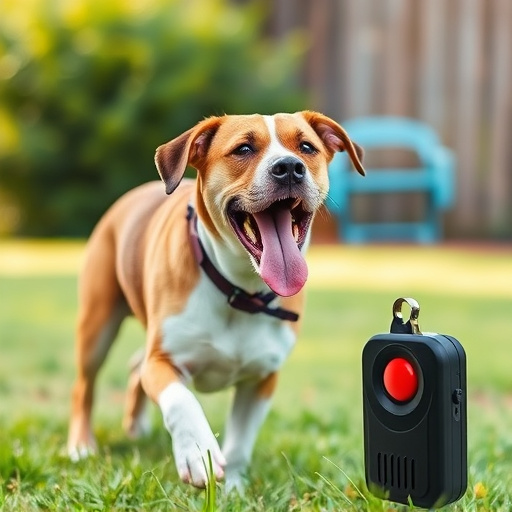Pets, especially dogs, communicate through barking, indicating needs or emotions. Effective pet deterrents like dog bark control devices use adjustable sound levels, leveraging a canine's sensitivity to specific frequencies. Owners can customize these settings for their pets' comfort and unique temperaments, preventing unwanted behaviors without causing harm. These devices prioritize safety with intuitive controls and durable designs, fostering trust in behavior management.
Introducing our comprehensive guide to revolutionary pet deterrents with adjustable sound levels. Understanding pet behavior is key to effective training, and customization plays a pivotal role in achieving desired outcomes. This article delves into the science behind sound-based deterrents, offering a step-by-step guide on adjusting intensity settings for optimal results. We explore safety, effectiveness, and user experience, emphasizing the importance of customize bark control intensity settings to create a harmonious living environment.
- Understanding Pet Behavior and Why Customization Matters
- The Science Behind Sound-Based Deterrents
- Adjusting Intensity Levels: A Step-by-Step Guide
- Safety, Effectiveness, and User Experience: Key Considerations
Understanding Pet Behavior and Why Customization Matters
Pets, especially dogs, communicate through a variety of vocalizations, with barking being one of their primary ways to express needs, fears, or excitement. Understanding this behavior is crucial when it comes to effective pet deterrents. Different pets have varying tolerances for sound intensity, and what might be a soothing volume for one dog could be intensely irritating to another. Customization, therefore, plays a vital role in ensuring the comfort and effectiveness of the deterrent.
Adjustable sound levels allow pet owners to tailor the device’s output according to their furry friend’s unique temperament. This feature is particularly beneficial when dealing with high-strung or sensitive pets that may react strongly to even moderate noise. By adjusting the bark control intensity settings, owners can find the perfect balance, creating an environment where their pets feel secure while also preventing unwanted behaviors like excessive barking.
The Science Behind Sound-Based Deterrents
The Science Behind Sound-Based Deterrents
Sound-based pet deterrents have gained popularity due to their non-invasive and humane nature. These devices use specific frequencies and decibels to emit sounds that disrupt animals’ behavior without causing them harm. The principle is based on the idea that certain noises can startle or annoy pets, encouraging them to avoid particular areas. For example, dog bark deterrents target high-pitched barks that are unpleasant to canines but inaudible to humans. By allowing users to customize bark control intensity settings, these devices offer a tailored approach to training and behavior modification.
This technology leverages the animal’s natural sensitivity to sound, particularly their hearing range. Different animals have varying thresholds for audibility and pain perception, so adjustable sound levels ensure that the deterrent remains effective yet safe. Users can gradually increase or decrease the volume and frequency to suit their pets’ needs, making it a versatile tool for training and maintaining a harmonious environment.
Adjusting Intensity Levels: A Step-by-Step Guide
Adjusting the intensity levels of your pet deterrent is a straightforward process that allows you to customize the experience according to your needs. Here’s a step-by-step guide:
1. Locate the Control Panel: Start by finding the control panel on your pet deterrent device. This is usually a small, handheld unit with buttons or a digital display.
2. Understand Sound Levels: Review the available sound level settings marked on the control panel. These levels are often represented by numbers or progressive bars indicating increasing intensity.
3. Select Desired Setting: Choose the suitable sound intensity based on your pet’s response and your preference. For example, lower settings might be ideal for training purposes, while higher levels can effectively deter persistent barking.
4. Adjust with Precision: Use the buttons to navigate and select the desired setting. Some devices offer precise adjustments, allowing you to fine-tune the volume or sound frequency.
5. Test and Evaluate: After setting the intensity level, test the device in a controlled environment to see if it achieves the intended effect. Adjust as needed until you find the perfect balance for your pet’s behavior.
6. Store Settings (if applicable): Certain models may allow you to save custom settings, making it easy to quickly select your preferred intensity level each time you use the device.
Safety, Effectiveness, and User Experience: Key Considerations
When considering a pet deterrent with adjustable sound levels, safety is paramount. Such devices should be designed to minimize potential harm to both pets and users, ensuring the well-being of all animals involved. Effective bark control systems achieve this by offering customizable intensity settings, allowing users to fine-tune the volume and frequency of sounds to suit their needs without causing discomfort or distress. This feature is crucial for addressing different barking scenarios and ensuring a safe environment for everyone.
User experience plays an integral role in the success of any pet deterrent. An intuitive interface with clear controls and customizable settings empowers owners to manage the device effectively. The ability to adjust sound levels on-the-go, especially during training or unexpected barking episodes, enhances responsiveness. Additionally, user-friendly designs that are durable and reliable contribute to a positive experience, fostering trust in the product’s effectiveness as a long-term solution for managing pet behavior.
Pet owners now have a powerful tool at their disposal with adjustable sound-based deterrents. By understanding pet behavior and customizing intensity settings, these devices offer a safe, effective solution to manage unwanted actions. With precise control over bark levels, folks can foster positive behavior changes without causing distress. This innovative approach to pet training is revolutionizing how we navigate the challenges of pet ownership, ensuring a quieter, more harmonious environment for all.
